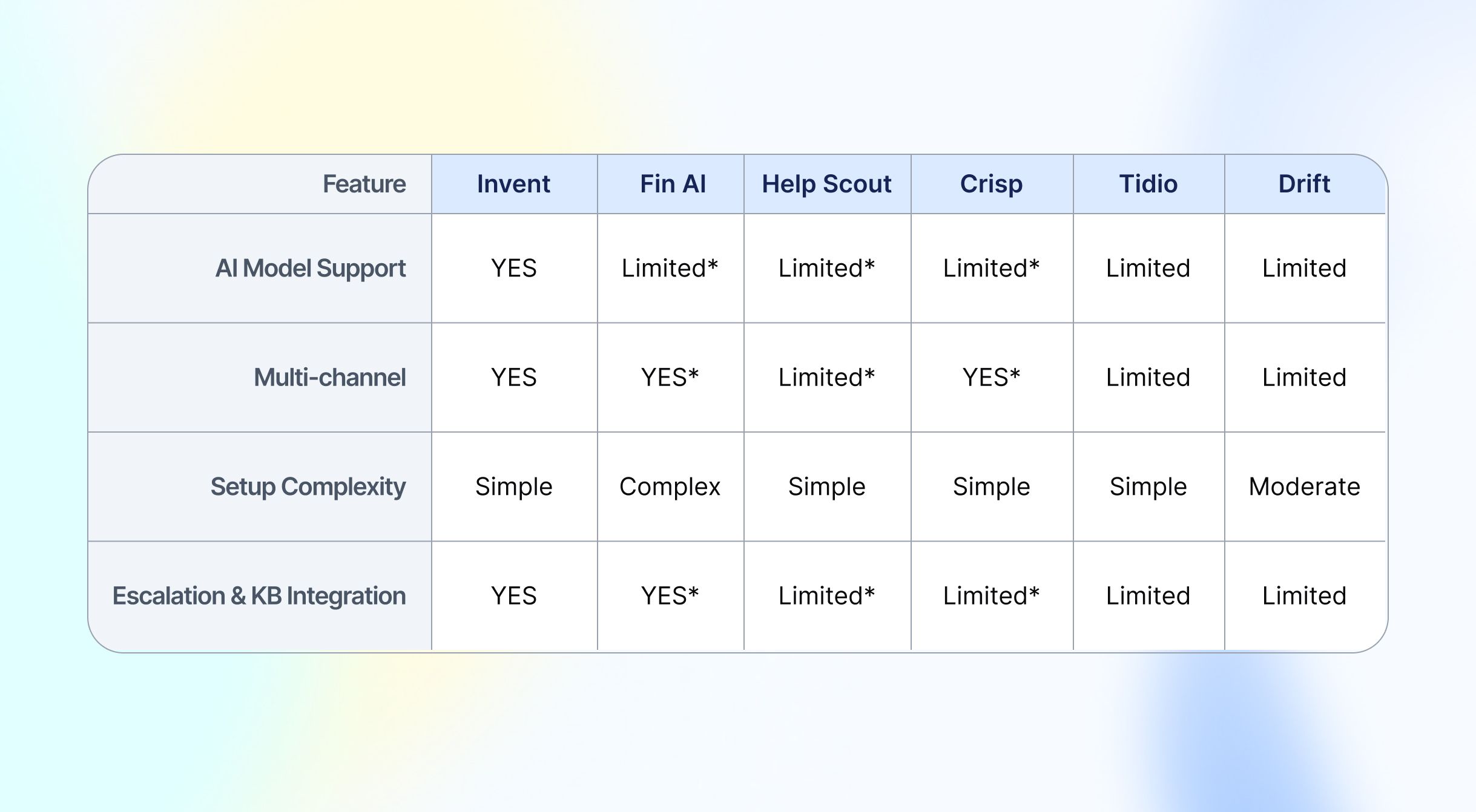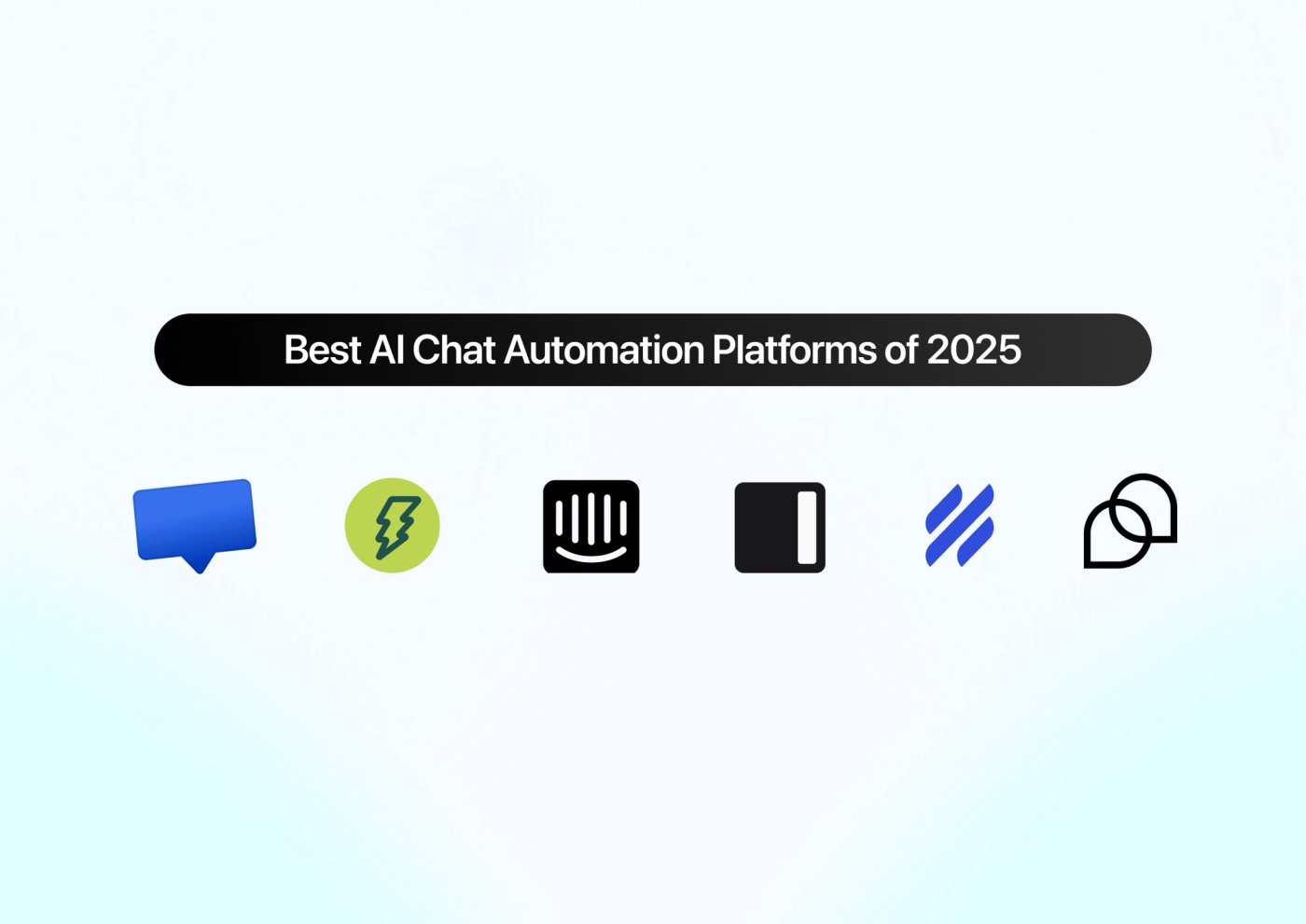As AI automation transforms customer support, businesses face critical decisions choosing the right AI chat platform to increase efficiency, improve CX, and scale multi-channel engagements seamlessly.
This in-depth 2025 comparison explores Invent, Intercom Fin AI, Help Scout, Crisp, Tidio, and Drift, highlighting their AI automation strengths, multi-channel support, pricing, and ideal use cases.
Why AI Chat automation platforms matter in 2025
AI chat automation boosts customer support by handling repetitive queries, qualifying leads, and enabling 24/7 multi-channel engagements via WhatsApp, SMS, email, Slack, Instagram, and more. Platforms today integrate advanced large language models (LLMs) such as GPT-4, Claude, Gemini, and Grok, supporting no-code workflow builders and voice-assisted AI agents. Choosing the right AI automation platform is vital for maximizing ROI through faster resolutions, reduced manual work, and seamless AI-human handoffs.
Invent: The multi-model, omnichannel AI unified Inbox
Invent stands out for its no-code design environment enabling product, marketing and CX teams to rapidly build scalable AI chatbots and assistants across diverse channels including WhatsApp, SMS, email, Instagram, Slack, and CRMs.
Unlike single-model platforms, Invent directly integrates various LLMs like GPT, Claude, Gemini, and Grok offering unmatched AI versatility for complex use cases beyond mere support automation.
Invent’s usage-based transparent pricing model empowers teams with predictable costs and freedom from platform lock-in. It excels at combining broad AI orchestration with flexible channel support and transparent billing, ideal for teams seeking enterprise-grade AI chatbots that integrate deeply with marketing and product workflows.
Intercom Fin AI: Embedded AI with strong support focus
Intercom’s Fin AI is a renowned enterprise assistant automating over 50% of inbound tickets using advanced context-aware multi-step dialogs. Fin integrates tightly within Intercom’s unified messenger and help center, offering features like procedure-based training, AI-powered simulations, and voice channel support. Its strengths lie in deep ecosystem embedding for support teams needing rich escalation, knowledge base integration, and comprehensive conversational AI.
However, Fin’s pricing based on seats plus per-resolution fees may result in higher costs as ticket volume scales. Its setup complexity and platform lock-in require companies ready for a more rigid, support-centric AI solution.
Help Scout: Ideal for simplicity and customer-focused support automation
Help Scout combines user-friendly AI chatbots with traditional help desk tools targeting smaller to mid-sized support teams. While it supports essential channels like email and web chat, its AI capabilities focus on streamlined FAQs and basic automation workflows. Pricing is straightforward but less oriented toward large-scale, multi-model AI orchestration.
Help Scout suits companies prioritizing ease of use and fast AI deployment with standard support-focused automation rather than broad marketing or product workflows.
Crisp: Conversational AI with visual messaging and shared inbox
Crisp offers a blended solution of AI-powered messaging, shared inboxes, and CRM features. Its conversational AI bots support SMS, email, and social media channels with visual messaging and multimedia support. Crisp emphasizes real-time conversations with AI assisting agents through suggestions and response automation.
Its straightforward setup and pricing appeal to SMBs needing an affordable, conversational AI assistant across popular messaging platforms.
Tidio: Best for no-Code AI chat automation for SMBs
Tidio’s platform champions no-code AI chatbot creation primarily for small businesses looking to automate FAQs, lead capture, and quick replies. Supporting web chat, Messenger, email, and Instagram, Tidio offers pre-built templates and affordable plans focused on ease for non-technical users.
Tidio is optimal for SMBs wanting to deploy AI-enhanced chatbots fast without complex multi-model AI configurations or extensive workflow customizations.
Drift: Real-Time B2B engagement with conversational AI
Drift specializes in real-time conversational marketing and sales engagement for B2B enterprises. It combines AI chatbots with live chat to qualify leads, book meetings, and provide personalized website experiences dynamically. Drift integrates well with CRM tools to close the loop on pipeline acceleration.
While powerful for sales-focused teams, Drift’s AI automation targets lead generation and real-time engagement more than broad customer support or multi-model AI workflows.
Feature Comparison Table: Invent vs Intercom, Help Scout, Crisp, Tidio, Drift

Invent stands out as the only platform with full support for AI models, multi-channel operations, simple setup, and robust escalation/knowledge base integration. Competitors mainly offer limited or partial functionality in these key areas.
Which Platform Should You Choose in 2025?
- Choose Invent if you want scalable, multi-channel AI automation with multi-model access and a flexible no-code design for marketing, product, and CX teams.
- Choose Intercom Fin AI if you need a deeply embedded AI support assistant with advanced escalation, voice integration, and can manage variable pricing.
- Choose Help Scout or Crisp for simpler, budget-friendly AI support automation targeting SMBs.
- Pick Tidio for no-code chatbot creation primarily for small businesses wanting quick, easy AI at low cost.
- Opt for Drift for B2B enterprises focused on conversational marketing and sales engagement automation.
Conclusion
In 2025, AI chat automation platforms differ widely in scope, pricing, and technical sophistication. Invent leads in multi-channel, multi-model AI flexibility enabling complex no-code workflow building broadening AI use beyond support. Intercom Fin AI excels as a premium embedded AI-first support assistant for enterprises. Meanwhile, Help Scout, Crisp, Tidio, and Drift serve specialized segments ranging from SMBs to B2B marketing teams.
Choosing the best platform depends on your organization’s AI maturity, channel needs, budget, and core use case, whether broad AI orchestration, embedded support AI, or conversational sales engagement. This comprehensive analysis can help guide your decision to leverage AI customer engagement effectively in 2025.

